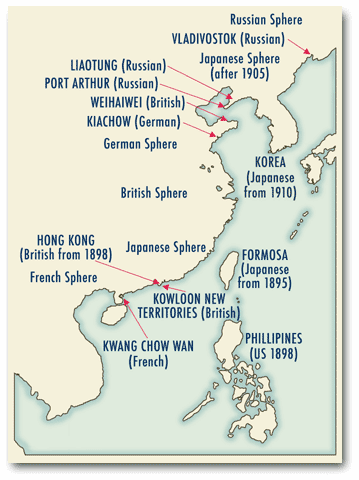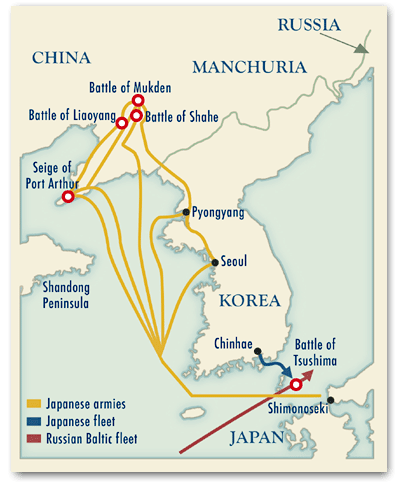| |
Japan’s victory over China in 1895 transformed global power politics. It shocked the world, crippled China, triggered a new epoch of imperialist avarice in Asia, and set Japan itself on a course of expansion that only ended 50 years later with the country’s devastating defeat in World War Two.
Before the war began, none of the Western powers anticipated or desired Japan’s victory. As soon as the war ended, they moved quickly to make victory bittersweet for the jubilant Japanese.
Japan’s immediate spoils from the war—set forth in the Treaty of Shimonoseki signed by the two countries on April 17, 1895—were extensive. China agreed to pay the victors a huge indemnity; to open seven new “treaty ports” to commerce; and to cede to Japan the Pescadores, Formosa (Taiwan), and a leasehold centering on Port Arthur at the tip of the Liaotung Peninsular.
Six days after the treaty was signed, the Japanese abruptly learned that power politics was an even harsher game than they had anticipated. In the notorious “tripartite intervention” of April 23, Russia, Germany, and France declared that a Japanese position in Liaotung (which controlled access to Beijing as well as Manchuria) would further destabilize the situation in Asia. The Japanese had no choice but to give up this strategic prize. As a standard diplomatic history text (by Paul Clyde and Burton Beers) puts it, “Thus Japan, who had won the war, lost the peace.”
That was but the half of it. If one goes on to ask who the big winners in this cynical business actually were, a reasonable answer would be: the non-belligerent Western powers themselves.
The Japanese did indeed still fare well. As compensation for pulling out of Liaotung, Japan received an increase in the already large indemnity China had agreed to pay. The final total (amounting to 330 million taels, or approximately “$170 million gold”

  Map of foreign holdings and spheres of Map of foreign holdings and spheres of
influence—1898 (and after).
|
at the time) more than covered Japan’s war expenses. Formosa remained in Japanese hands—its first colonial plum. And Chinese influence in Korea—the ostensible reason for going to war in the first place—had been eliminated.
For China, on the other hand, the war and subsequent indemnity were ruinous; and it was this that enabled the Western powers to demonstrate what “wealth and power” really amounted to in this age of carnivorous statecraft. China had financed the war largely through loans from the British. To pay the indemnity, it was forced to take out a succession of additional loans from Russia, France, England, and Germany—in return for which the foreign powers proceeded to extract territorial leaseholds and exclusive rights that essentially placed them in control of China’s railroads, mines, and harbors. The Western powers also welcomed the new “treaty ports” Japan had forced China to open as part of the Shimonoseki settlement, which enabled them to exploit the China market more freely than ever before.
This dismemberment took place between 1895 and 1898 and was known at the time by phrases such as the “scramble for concessions” and the “breakup” or “partition” of China. In a tastier metaphor, it also was referred to as “slicing the Chinese melon.” Russia, Germany, and France—who had instigated the “tripartite intervention” in the name of preserving China’s integrity—all seized this opportunity to carve off pieces of China. Germany, for example, gained special rights in Kiaochow (Jiaozhou) and became preeminent in the Shantung peninsula. France focused on Kwangchow (Guangzhou) and the area bordering Indochina. Russia took over Port Arthur and the Liaotung leasehold and appeared poised to dominate Manchuria and Korea. (Port Arthur offered the ice-free “eastern” harbor Russia desperately desired.) British capital became dominant in the Yangtze valley through major concessions in Weihaiwei and Kowloon (Jiulong). By 1899, as Clyde and Beers observe, the foreign powers had “reduced strategic areas in China to semi-colonial status.”
The United States did not join in slicing the melon. Its policy, not fully articulated until 1899, was to call vaguely (and ineffectively) for an “open door” that would respect China’s integrity while maintaining a commercial market accessible to all. Simultaneously, however, and more pertinent in Japanese eyes, the United States had plunged into its own splendid little war and was lopping off its own colonial enclave in Asia. The war was the Spanish-American War, and the colonial prize—many thousands of miles away from Cuba, where hostilities had broken out—was the Philippines, which the United States seized from Spain in 1898 and subsequently subjugated at an enormous cost in Filipino lives.
The signal moment in the American takeover of the Philippines took place when Admiral George Dewey destroyed the Spanish fleet in Manila Bay. This was a stirring naval victory much like those Japan had savored in the Sino-Japanese War—and would soon savor again against Tsarist Russia—and it found an unexpected Japanese chronicler. Dewey’s victory was celebrated in a garish woodblock triptych that even bore an English title: “Battle of Manila, May 1, 1898.”
|
 
1898: America Moves into Asia
Three years after the Japanese victory over China, the United States attacked the Spanish fleet in the Bay of Manila and, after a long and bloody struggle against native resistance forces, took over as colonial overlords of the Philippines. The age of imperialism in Asia had now entered a new stage.
|
| |
  “Battle of Manila, May 1, 1898,” artist unidentified (with details) “Battle of Manila, May 1, 1898,” artist unidentified (with details)
[res.54.160] Museum of Fine Arts, Boston
|
 |
|
Confronted with these latest lessons in “Westernization,” Japan’s leaders redoubled their efforts to build a military capable of playing the power game more decisively. 10 years after instigating war against China, Imperial Japan initiated hostilities against Tsarist Russia with the goal, once again, of establishing hegemony in northeast Asia.
The Russo-Japanese War began in February 1904 and ended in September 1905. The battle zone overlapped with that of the earlier war, centering on Manchuria and surrounding seas (there was little actual fighting in Korea itself, although armies were deployed there). For the Japanese, taking on Russia had all the risk and drama that had been present in the war against China, and more.

  The Russo-Japanese War began in February The Russo-Japanese War began in February
1904 and ended in September 1905.
|
The stakes were higher. This time the enemy was not the moribund “Asia” that China had symbolized. Rather, it was one of the great powers that had descended on Japan in the 1850s and saddled it with the onerous unequal-treaty system.
This time the enemy was associated with the white, Christian, expansionist “West” itself.
The battles, moreover, were titanic and state-of-the-art. A Japanese armada of battleships, destroyers, cruisers, and torpedo boats initiated the war with a surprise attack on February 8 that drove Russia’s Far Eastern Fleet into the harbor at Port Arthur and blockaded it there. (Japan formally declared war two days later.) Japanese armies fought their way through Manchuria and down the Liaotung Peninsula, eventually sinking the bottled-up Russian fleet from surrounding mountaintops with the largest artillery ever used in modern warfare to that date. In the Battle of Mukden early in 1905, a quarter-million Japanese confronted a Russian force of some 320,000 men. When the Russians sent their Baltic Fleet of 45 warships around the world to Port Arthur, Admiral Tōgō Heihachirō’s combined force annihilated it off the Straits of Tsushima in one of the most celebrated victories in modern naval history. All told, around a million Japanese were mobilized for the war.
The Russo-Japanese War also had a greater overlay of tragedy for the Japanese than the war against China did, for victory was purchased with a heavy blood debt. In contrast to the Sino-Japanese War, where fatalities were surprisingly small, around 90,000 Japanese were killed in combat or by illness and bitter cold (Russian fatalities were even larger.) This was a sobering price to pay for finally establishing Japan as an independent, modern, imperialist nation. Until the end of World War Two, the anniversary of the Battle of Mukden was celebrated as Army Day (March 10) in Japan, and the anniversary of the Battle of Tsushima as Navy Day (May 27).
|
|
|

